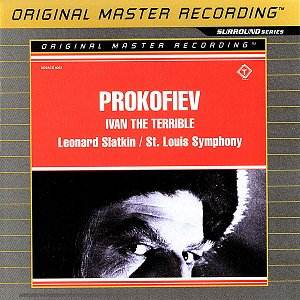Comparison Recordings:
Neeme Järvi, Philharmonia Orchestra,
Chorus, and soloists Chandos 8977
Dmitry Yablonsky (Oprichniksí Dance
and Polonaise) Naxos DVD-Audio 5.110015
Riccardo Muti, Philh.O, Ambrosian Singers,
and soloists EMI QUAD LP SLS5110
This film is more difficult
to appreciate than Alexander Nevsky,
perhaps partly because it is much longer,
but is if anything more skilfully produced.
Even though part two was banned by Stalin,
the original materials were all perfectly
preserved and the complete film has
been excellently restored including
the colour ballet sequence at the banquet,
although public domain unrestored prints
are still commonly sold. As with most
classic films, do not attempt to evaluate
critically an incomplete, unrestored
print; the damage done by careless handling
and clumsy re-editing can utterly defeat
the artistry in the original. This film
being less spectacular, and more complex
and dramatic than Nevsky, the
music plays a less critical part, making
a more subtle contribution.
Muti conducts complete
the 23 numbers of the Stasevich oratorio
(on 3 LP sides, the fourth given over
to a performance of the Sinfonietta,
Op. 48) and is discussed here partly
because it could some day soon appear
as a surround sound DVD Audio or SACD
disk. Slatkin omits the narrator and
inserts just before the finale the Polonaise
movement from Prokofievís music for
Boris Godunov (1957). This also
appears in Rozhdestvenskyís "Pushkiniana"
suite (1962) arranged from Prokofievís
unfamiliar stage music. This addition
gives an augmented work of 24 movements.
The notes assure us that the narrator
part was recorded; Slatkinís decision
not to use it having been made after
the music was "in the can"
and entirely for artistic reasons. The
Boris Polonaise is performed
with more verve by Yablonsky, but the
sound, even on the CD tracks, is better
on the Slatkin recording. I donít see
the Polonaise, interesting though
it is, adding anything to the Ivan
Suite, but youíre free to program it
in or out when you play the disk. Järviís
disk omits the narrator and also four
movements ("arr. Palmer")
to produce a 59 minute suite which could
have fit on an LP at the time of its
release in 1991. But Järvi has
recently recorded a new and more complete
version which I have not heard. It will
also likely someday be released on SACD
multi channel, so in the near future
one may have three high resolution recordings
of this music to choose among ó not
surprising since the score is so extremely
colourful.
The contralto aria
"The Broad Expanse of the Sea"
(selection two or three depending on
whether or not the "March of the
Young Ivan" is cut) contains, near
the beginning, an awkward register change
for the vocalist. Irina Arkhipova on
the Muti recording deals with this most
successfully and is overall the most
dramatic and idiomatic of the vocalists,
with Järviís Linda Finnie a close
second. Slatkinís Claudine Carlson has
a sweeter, more attractive sound. The
narration does add interest even if
you canít understand Russian and Boris
Morgunov on the Muti recording ó the
only one to include the narration ó
is a model of clear diction if you want
to practise your Russian accent. The
choruses are all great and acoustically
quite forward, except on the Muti recording
which has, not surprisingly, a more
operatic balance among the forces.
Slatkinís mother and
father were both exceptional musicians
who have left us many fine recordings.
My impression of Leonard Slatkin as
a conductor is that he is very similar
to Sir Adrian Boult in style, an impression
borne out by his demonstrated skill
at playing Vaughan Williams and Elgar.
His orchestra is always balanced, his
tempi always so reasonable, the rhythm
clear and dead on, and the dramatic
emotional aspect of the music just ever
so slightly underplayed in comparison
to others. Why would anybody ever want
to underplay the emotion in the music?
Simply so that other aspects of the
music become more evident and the result
is a richer overall musical experience.
If you want heaven-storming passion
or wet sleeve sentimentality, you always
have Bernstein and Stokowski.
All the versions have
exceptionally clear sound but, even
on the CD tracks, the Slatkin recording
has the best recording quality. As with
earlier releases on this label, and
in contrast to some Hybrid CDs Iíve
heard, the CD tracks are noticeably
better than average in clarity and freedom
from downsampling artefacts (which would
include harsh or weak highs, clicks
in percussion sounds, and attenuated
bass). Even if you never buy an SACD
player, this CD will be one of the finest
sounding disks in your collection. In
fact the difference between the CD tracks
and the SACD tracks, while significant,
is not overwhelming. If you were to
walk into the room while the disk was
being played, it might take you, say,
ten seconds before you could tell for
sure whether the CD or SACD track was
playing. The surround sound is entirely
ambient, so the two channel CD tracks
played through a Dolby decoder give
a comparable, if less precise, ambient
experience.
If you already have
the 1991 Järvi recording on Chandos,
you already have the music presented
as well as it needs to be. If you want
to replace it with a surround sound
version you might want to wait a while
and see what other recordings come to
market.
Paul Shoemaker
